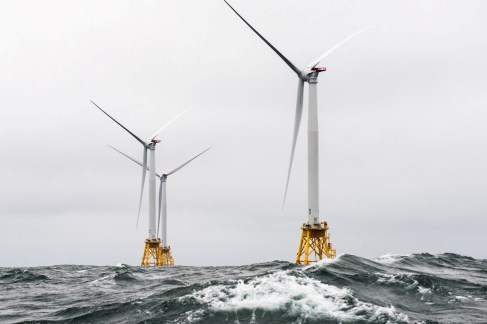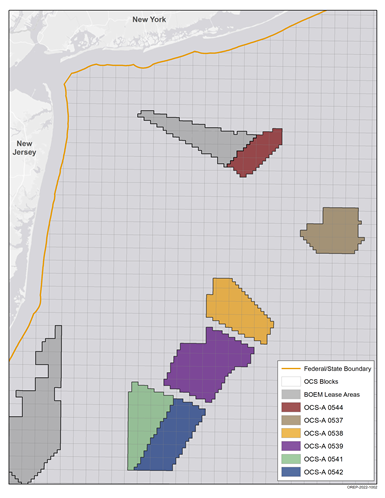U.S. sets offshore energy records with $4.37 billion in winning bids for wind sale
The New York Bight offshore wind sale offered six lease areas totaling more than 488,000 acres won by six bidding companies. Up to seven more potential lease sales have been identified for later this year.

Photo Credit, all images: Department of the Interior (DOI)
The U.S. Department of the Interior (Washington, D.C., U.S.) announced the results of the United States’ highest-grossing competitive offshore energy lease sale to date, including oil and gas lease sales, with the New York Bight offshore wind sale. These results are reported to be a major milestone towards achieving the current administration’s goal of reaching 30 gigawatts (GW) of offshore wind energy by 2030. The lease sale offered six lease areas totaling more than 488,000 acres in the New York Bight — extending along the Atlantic coast from Cape May Inlet in New Jersey to Montauk Point — for potential wind energy development and drew competitive winning bids from six companies totaling approximately $4.37 billion.
Moreover, a recent report indicates that the United States’ growing offshore wind energy industry presents a $109 billion revenue opportunity to businesses in the supply chain over the next decade.
“This week’s offshore wind sale makes one thing clear: the enthusiasm for the clean energy economy is undeniable and it’s here to stay,” says Secretary Deb Haaland. “The investments we are seeing today will play an important role in delivering on the Biden-Harris administration’s commitment to tackle the climate crisis and create thousands of good-paying, union jobs across the nation.”
The provisional winners of this lease sale are:
| Provisional Winner | Lease Area | Acres | Winning Bid |
| OW Ocean Winds East LLC | OCS-A 0537 | 71,522 | $765,000,000 |
| Attentive Energy LLC | OCS-A 0538 | 84,332 | $795,000,000 |
| Bight Wind Holdings LLC | OCS-A 0539 | 125,964 | $1,100,000,000 |
| Atlantic Shores Offshore Wind Bight, LLC | OCS-A 0541 | 79,351 | $780,000,000 |
| Invenergy Wind Offshore LLC | OCS-A 0542 | 83,976 | $645,000,000 |
| Mid-Atlantic Offshore Wind LLC | OCS-A 0544 | 43,056 | $285,000,000 |
A map of the lease areas auctioned is shown in the image to the right. A more detailed rendition can be found on the Interior’s Bureau of Ocean Energy Management (BOEM) website.
Before the leases are finalized, the Department of Justice and Federal Trade Commission will conduct an anti-competitiveness review of the auction, and the provisional winners will be required to pay the winning bids and provide financial assurance to BOEM.
The New York Bight offshore wind leases include innovative stipulations designed to promote the development of a robust domestic U.S. supply chain for offshore wind energy and enhance engagement with Tribes, the commercial fishing industry, other ocean users and underserved communities. The stipulations will also advance flexibility in transmission planning. Stipulations include incentives to source major components domestically — such as blades, turbines and foundations — and to enter into project labor agreements to ensure projects are union-built.
On Jan. 12, Secretary Haaland, New Jersey Governor Phil Murphy and New York Governor Kathy Hochul announced a shared vision for developing a robust offshore wind energy domestic supply chain that will deliver benefits to residents of New York and New Jersey and the surrounding region, including underserved communities. This collaboration will serve as a model for future engagement and establish the U.S. as a major player in the global offshore wind energy market.
To advance the Interior Department’s environmental justice and economic empowerment goals, lessees will be required to identify and make efforts to engage with Tribes, underserved communities and other ocean users who could be affected by offshore wind energy development. The Department will hold companies accountable for improving their engagement, communication and transparency with these communities.
These additions are intended to promote offshore wind energy development in a way that coexists with other ocean uses and protects the ocean environment, while also securing the United States’ energy future for generations to come.
BOEM initially asked for information and nominations of commercial interest on 1.7 million acres in the New York Bight. Based on BOEM’s review of scientific data and extensive input from the commercial fishing industry, Tribes, partnering agencies, key stakeholders and the public, BOEM reduced the acreage offered for lease by 72% to avoid conflicts with ocean users and minimize environmental impacts. BOEM will continue to engage with the public, ocean users and key stakeholders as the process unfolds.
It has been reported that the current administration has already made significant progress toward creating a pipeline of projects. It has approved and celebrated the groundbreaking of the nation’s first two commercial-scale offshore wind projects in federal waters: the 800-megawatt (MW) Vineyard Wind project and the 130-MW South Fork Wind project. BOEM expects to review at least 16 plans to construct and operate commercial offshore wind energy facilities by 2025, which would represent more than 22 GW of clean energy for the nation.
In addition, this past fall Secretary Haaland announced a new leasing path forward, which identified up to seven potential lease sales by 2025, including the New York Bight and offshore the Carolinas and California later this year, to be followed by lease sales for the Central Atlantic, Gulf of Maine, the Gulf of Mexico and offshore Oregon.
Related Content
Achieving composites innovation through collaboration
Stephen Heinz, vice president of R&I for Syensqo delivered an inspirational keynote at SAMPE 2024, highlighting the significant role of composite materials in emerging technologies and encouraging broader collaboration within the manufacturing community.
Read MoreDrag-based wind turbine design for higher energy capture
Claiming significantly higher power generation capacity than traditional blades, Xenecore aims to scale up its current monocoque, fan-shaped wind blades, made via compression molded carbon fiber/epoxy with I-beam ribs and microsphere structural foam.
Read MoreNCC reaches milestone in composite cryogenic hydrogen program
The National Composites Centre is testing composite cryogenic storage tank demonstrators with increasing complexity, to support U.K. transition to the hydrogen economy.
Read MorePolar Technology develops innovative solutions for hydrogen storage
Conformable “Hydrogen in a Box” prototype for compressed gas storage has been tested to 350 and 700 bar, liquid hydrogen storage is being evaluated.
Read MoreRead Next
VIDEO: High-volume processing for fiberglass components
Cannon Ergos, a company specializing in high-ton presses and equipment for composites fabrication and plastics processing, displayed automotive and industrial components at CAMX 2024.
Read MoreAll-recycled, needle-punched nonwoven CFRP slashes carbon footprint of Formula 2 seat
Dallara and Tenowo collaborate to produce a race-ready Formula 2 seat using recycled carbon fiber, reducing CO2 emissions by 97.5% compared to virgin materials.
Read MoreDeveloping bonded composite repair for ships, offshore units
Bureau Veritas and industry partners issue guidelines and pave the way for certification via StrengthBond Offshore project.
Read More

























